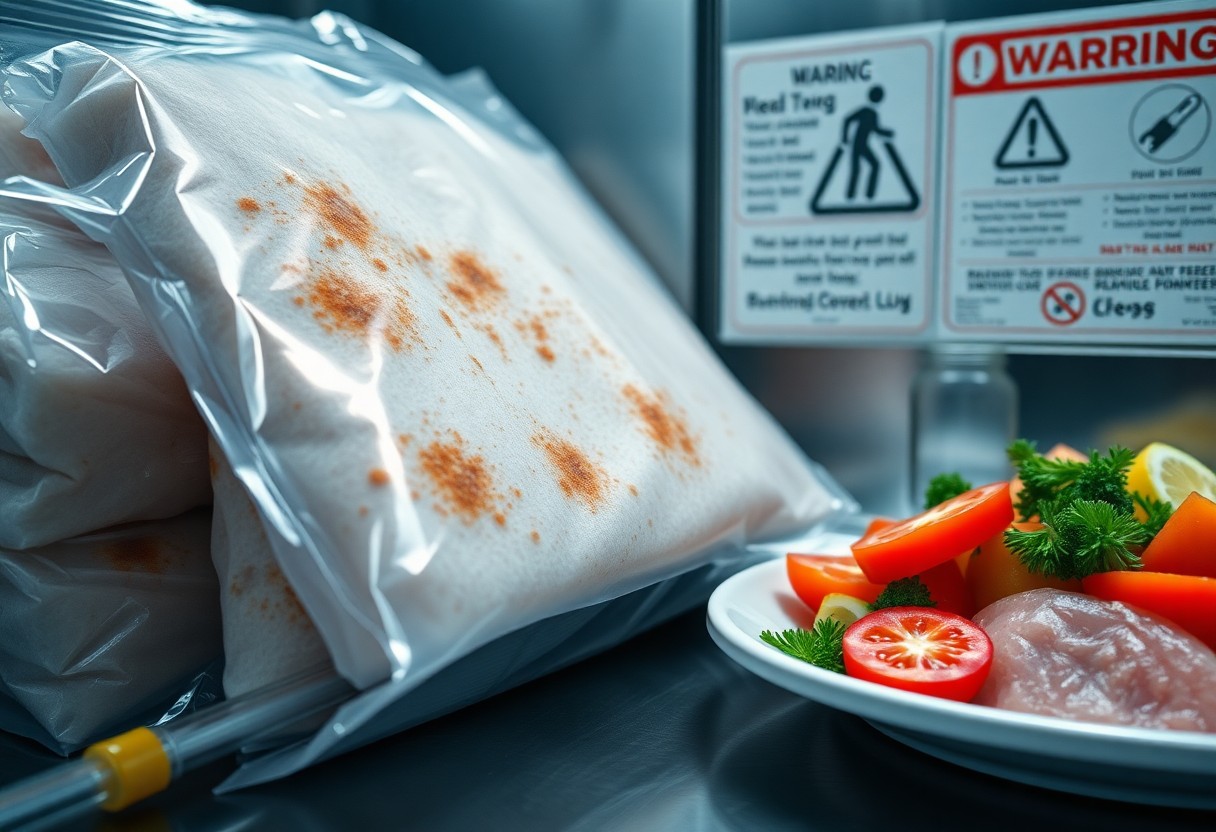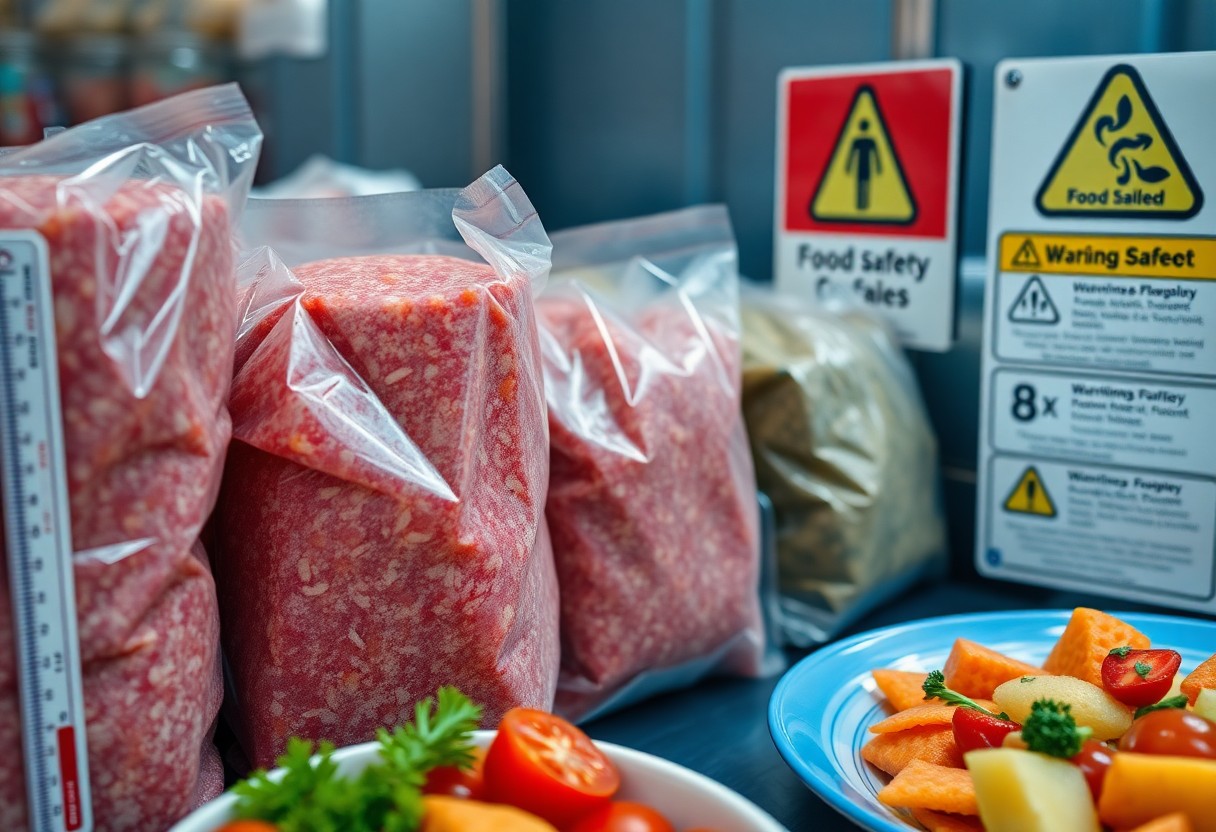You may have noticed freezer burn on food stored for too long, and you might wonder if it poses any health risks. While freezer burn itself is not dangerous and does not cause food poisoning, it can affect the quality and taste of your food. However, understanding how to properly freeze and store items can help you avoid the loss of flavor and texture. This post will discuss the implications of freezer burn and guide you on how to safeguard your food for the future.

Key Takeaways:
- Freezer burn occurs when food is exposed to air, leading to dehydration and changes in texture and flavor, but it is not harmful to consume.
- While freezer-burned food may not taste great, it does not pose a risk of food poisoning if properly stored and handled.
- To minimize freezer burn, ensure food is well-wrapped and stored in airtight containers, and maintain a consistent freezer temperature.
Understanding Freezer Burn
For anyone who stores food in the freezer, understanding freezer burn is vital. This phenomenon occurs when air reaches the food’s surface, leading to dehydration and oxidation. It commonly appears as grayish-brown spots or a dry, leathery texture on frozen items. While freezer burn is not dangerous, it can negatively affect the taste, texture, and quality of your food.
What is Freezer Burn?
Around frozen foods, freezer burn is a common issue that arises when moisture in the food evaporates, leaving behind hardened, discolored patches. The process occurs due to poor packaging or prolonged exposure to air, and while it doesn’t make the food unsafe, it can significantly diminish its flavor.
Causes of Freezer Burn
Against popular belief, freezer burn is not just a result of freezing food for too long; it’s primarily caused by improper storage. If your food is not sealed tightly or if it’s left unprotected, air can infiltrate. This exposure leads to dehydration and consequent freezer burn, affecting the quality of your food.
Also, think about how you package your food before freezing. Using airtight containers or vacuum-sealed bags can prevent air from reaching your food. If you notice changes like ice crystals forming or a dry texture, your food may be experiencing freezer burn. While it won’t cause food poisoning, discarding these affected portions can help maintain the overall flavor and quality of your meals.

The Science of Food Preservation
Assuming you’re curious about the mechanisms behind food preservation, understanding the science is key. Food preservation techniques, like freezing, prevent the growth of bacteria, molds, and yeasts by lowering the temperature to a point where these organisms cannot thrive. This method effectively extends the shelf life of your food, maintaining its nutritional value and safety for consumption.
Freezing Techniques
Behind every effective freezing method lies the principle of rapid temperature drop. When you freeze food quickly, you minimize the size of ice crystals that form, preserving the texture and quality of the food. By using proper packaging and temperature settings, you can reduce the risk of freezer burn and maintain the overall integrity of your stored items.
Effects on Food Quality
One of the main considerations when freezing food is its quality after thawing. Freezer burn, caused by air exposure, can lead to lost moisture and altered flavors. While it typically presents no health risks, it can affect your eating experience.
But the effects of freezer burn can go beyond just taste. You may notice discoloration and an unpleasant texture when you thaw and cook food that has been freezer-burned. It’s important to know that while the food remains safe to eat, the quality may suffer significantly. By packaging food securely to limit air exposure and maintaining a consistent freezing temperature, you can greatly enhance your food’s longevity and flavor, ensuring you enjoy it to the fullest when you decide to consume it.
Safety Concerns Related to Freezer Burn
Your primary concern with freezer burn is not just the effect on taste and texture, but also the potential safety concerns. While freezer burn occurs when food is exposed to air, resulting in dehydration and oxidation, the good news is that it doesn’t generally lead to foodborne illnesses. However, if the food was already contaminated prior to freezing, the risks could still be present, making safe handling practices important.
Are There Health Risks?
The truth is, freezer burn itself is not hazardous to health. It does not pose direct health risks in terms of food poisoning. However, it can lead to a degraded food quality and you may find the affected items unappetizing. If harmful bacteria were present when initially frozen, they could survive and cause foodborne illness once thawed.
Myths vs. Facts
One common myth is that freezer burn makes food unsafe to eat. In fact, while freezer burn can negatively impact the flavor and texture of food, it does not increase the risk of illness. You can safely consume freezer-burned food as long as it was properly handled before freezing.
Risks associated with freezer burn are often overstated. Freezer burn does not introduce harmful pathogens that can lead to food poisoning. Instead, it affects the quality of the food, leading to dry or off-flavored ingredients. The important takeaway is that food safety largely depends on proper handling and storage practices from the very beginning. Always ensure your food is clean before freezing to mitigate any potential health issues.
Identifying Freezer Burn
Keep an eye out for signs of freezer burn on your food to ensure its quality. Freezer burn occurs when food is exposed to air, leading to dehydration and changes in texture and flavor. Commonly affected items include meat, vegetables, and fruits that have been inadequately wrapped or stored for too long. Recognizing these signs can help you maintain your food’s taste and safety.
Signs of Freezer Burn
Among the most common signs of freezer burn are white or grayish-brown patches on the surface of your food, which indicate ice crystals forming. You may also notice dry spots or a change in texture, such as toughness or a grainy feel. These visual cues tell you that your food has lost moisture and may not taste its best.
When to Discard
Freezer burn can affect the quality of your food, but it’s not always unsafe. However, if the burn is severe and the texture or taste is significantly compromised, it’s best to discard it. You should particularly be wary of items that have developed a strong off-odor or an unprecedented flavor, as these may signal that the food has gone bad.
Identifying when to discard food is important for your health. If you notice extensive freezer burn, high levels of dehydration, or unpleasant smells, it’s advisable to throw the food away to prevent any risk of foodborne illness. Foods that have been left in the freezer for too long, especially ones that are discolored or produce an off-taste, should also be discarded to ensure your safety while enjoying your meals.
Mitigating the Effects of Freezer Burn
Despite having a negative impact on the quality of your frozen food, you can take steps to mitigate the effects of freezer burn. Using proper freezing techniques and adhering to effective food storage practices will help maintain taste and texture. By addressing potential issues proactively, you can enjoy your meals without sacrificing quality or safety.
Proper Freezing Methods
Along with understanding the risks of freezer burn, it is vital to employ proper freezing methods. Use airtight containers or vacuum-sealed bags to minimize exposure to air, which is a primary cause of freezer burn. It’s also advisable to freeze food in small portions, allowing for quicker freezing and thawing, preserving your food’s integrity.
Best Practices for Food Storage
Proper food storage is key to reducing the chances of freezer burn. Ensure your freezer is set at 0°F (-18°C) or lower and that food is organized in a way that promotes efficient air circulation. Avoid overpacking your freezer, as this can obstruct airflow and lead to inconsistent freezing. Additionally, labeling food with dates can help you keep track of freshness and safety.
Storage plays a significant role in maintaining your food’s quality. Utilize space-efficient containers and vacuum-sealed bags to limit exposure to air and moisture. Try to consume your frozen items within the recommended time limits—typically within 3 to 12 months depending on the food type—to avoid potential spoilage. By following these best practices, you can effectively prevent freezer burn and enjoy your meals without compromising safety or flavor.
To wrap up
Upon reflecting on the implications of freezer burn, you can feel reassured that it is not a direct threat to your health. While freezer burn may compromise the quality and flavor of your food, it does not contribute to food poisoning risks. However, ensuring proper food storage techniques and vigilance with expiration dates can help protect you from potential contaminants. Understanding these nuances allows you to make informed decisions about your frozen goods, ensuring that your meals remain safe and enjoyable.
Q: What is freezer burn, and how does it occur?
A: Freezer burn occurs when moisture evaporates from food while it is stored in the freezer, leading to dehydration and the formation of ice crystals on the surface. This often happens when food is not properly wrapped or sealed, allowing air to come into contact with it. The result is dry, sometimes discolored patches on the food, which can affect quality but not necessarily safety.
Q: Can freezer burn make food unsafe to eat?
A: No, freezer burn itself does not make food unsafe to eat. It is primarily a quality issue rather than a safety concern. While freezer-burned food can lose its texture and flavor, it is still safe from a food poisoning perspective, provided it was frozen while still fresh and has been stored correctly.
Q: How can I prevent freezer burn when storing food?
A: To prevent freezer burn, ensure that food is tightly wrapped in airtight packaging, such as vacuum-sealed bags or heavy-duty aluminum foil. You can also use freezer containers that are specifically designed to reduce air exposure. Be sure to remove as much air as possible from bags or containers before sealing and avoid overloading the freezer, which can prevent proper air circulation.
Q: What are the signs of food that has freezer burn?
A: Signs of freezer burn include dry spots or ice crystals on the surface of the food, changes in color (such as grayish or whitish patches), and a rough or leathery texture. While it may not look appetizing, food with freezer burn is still safe to consume; however, cutting away the affected areas can help improve the taste and texture.
Q: Should I discard food that has freezer burn?
A: It is not necessary to discard freezer-burned food as it is safe to eat. However, to maintain the best quality, consider trimming off the affected areas before cooking. If the flavor or texture is too altered for your liking, you may choose to discard it, but it is primarily a matter of personal preference rather than safety.
